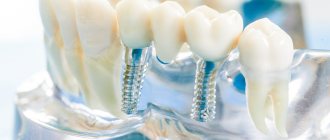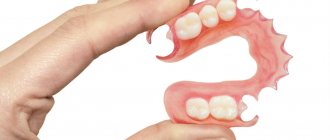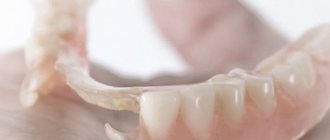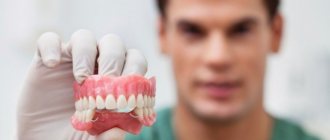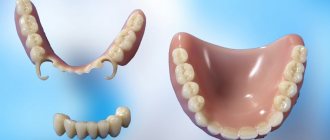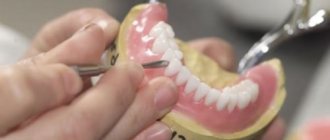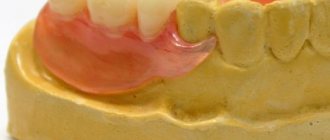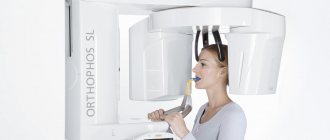What is a nylon prosthesis
Removable nylon dentures are soft orthopedic structures made of a pink, gum-colored nylon base with invisible clasps that hold it in the mouth. The fixation is on the adjacent teeth; the hooks wrap around the supports, keeping the prosthesis stationary on the jaw. Artificial crowns are placed on an elastic frame.
A person can take off and put on a nylon prosthesis without assistance. They are used in dentistry as a temporary solution during implantation (during the process of osseointegration) or as a permanent prosthesis according to indications.
Nylon is a polymer that has the quality of flexibility, and under certain conditions, in the patient’s mouth, softness increases. As a denture material, it has come as an alternative to dental acrylic, to which some people are allergic.
Partial nylon prosthesis RUR 40,000. for all!
The price includes: diagnostics, impressions, manufacturing, installation, fitting and 1 year warranty! Complete denture Akrifri 1 jaw - 47,000 rub.!
Advantages of Denta-Med
Our clinic is distinguished by loyalty to patients and constant improvement of reception conditions. We are constantly working to improve the quality of service. Therefore, our clients can receive dental prosthetics at competitive prices and a lot of pleasant bonuses.
Features of the service at the Denta-Med dental clinic include:
- Last minute welcome. 30% discount on suddenly free time.
- Discount. The “Successful Dentistry” prize card allows you to receive discounts and pleasant gifts as a result of the drawing. Anyone can receive it after an appointment at our dentistry.
- Convenient payment services. We have tried to make our services as accessible as possible to different categories of citizens. Therefore, we offer dental prosthetics in installments on convenient lending terms.
Stages of manufacturing a flexible prosthesis
To create nylon dentures, you must first treat the teeth, perform removal according to indications, and then proceed to the following steps:
- taking impressions of jaws in a clinical setting;
- plaster models are made in the laboratory;
- a wax prototype of the prosthesis is cast, tried on, and finalized;
- a nylon final version is created, matched to the color of the gum. The equipment used is a heat press, in which polymer granules are melted and an individual mold is poured in a liquid state. After hardening, the structure is polished.
Clasps are a continuation of nylon dentures and are therefore completely invisible on the jaw even when smiling and talking.
Manufacturing and installation
A person who decides to install soft nylon dentures must first come to the A-Medic clinic so that the doctor determines the feasibility of installing them. If there are no obstacles to the implementation of the plan: there are no contraindications, and the gums and the oral cavity as a whole are in good condition, then prosthetics are possible. In the presence of inflammation and carious teeth, the process is postponed until these problems are eliminated. That is, the patient must undergo oral sanitation.
If everything is in order, the doctor makes impressions of the jaw, which are sent to the laboratory, where specialists will make a plaster model of it. Initially, the orthodontic structure is made of liquid wax, and it is this that is involved in the first fitting. The production of nylon prostheses begins only when the doctor is completely convinced that the wax copy “fits like a glove” and there are no complaints about it. This product is cast in a heat press, after which it is installed in its place. Any specialist involved in dental prosthetics must tell the patient about all the intricacies and difficulties of caring for an orthodontic structure.
Indications for installation
Indications for removable nylon dentures can be:
- loss of one or more teeth in a row;
- scattered defect;
- absence of all teeth;
- allergy to metal, acrylic;
- if you do not want to grind the supporting teeth for dentures, for example, clasp ones with locks;
- periodontal disease of 1st and 2nd degrees to keep teeth in place (but 3.4 degrees will already be a contraindication);
- patient refusal or medical contraindications to implantation;
- childhood, if necessary, hide early tooth loss;
- as a temporary solution for implantation with delayed loading.
Sometimes nylon dentures can be installed to treat bruxism, involuntary grinding in the mouth, which damages tooth enamel and increases wear. And also for athletes and people involved in traumatic sports, a flexible design is the best option, better than acrylic, which can easily break in case of injury.
Contraindications
What may be a contraindication to a nylon prosthesis in dentistry:
- periodontal diseases (grade 3-4 periodontal disease), loose teeth, their displacement;
- recession;
- the height of the supporting teeth is not enough, the clasps will not be able to securely fasten;
- inflammatory processes of the mucous membrane and gums;
- tooth mobility;
- significant bone atrophy.
It is necessary to have healthy teeth on both sides of the prosthesis as supports for clasp fixation.
Where to contact
Patients with removable orthopedic devices are recommended to see an orthopedist every 6 months
for relocation of the structure. This must be done for preventive purposes, since due to a violation of the fixation of the orthopedic system in the mouth, breakage of the structure, rapid loosening and loss of supporting teeth (with partial structures) may occur.
To restore a prosthesis in Moscow, it is most convenient to contact the RUTT network of clinics. Relining is carried out using modern cushioning materials from reliable manufacturers, which guarantees precise fit of the restored structure, uniform distribution of the chewing load, and long service life.
Expert of the article Alekperov Roman Borisovich Dentist-orthopedist, doctor of the first category
Work experience24 years
Varieties
There are:
- mini dentures for 1-2 teeth;
- partial (in the absence of three or more teeth);
- complete (replacing the dentition of the entire jaw).
Many people mistakenly believe that all flexible prostheses are nylon. This is wrong. They are very similar to the touch and in some characteristics. However, they should be considered separately.
Quadrotti prosthesis
A special modern type of prosthesis, which stands somewhere between clasp and nylon. It is more durable than the latter, has a little flexibility, and the fasteners are also not visible, unlike the clasp design, where, perhaps, this is the only drawback. The material of manufacture is monomer-free plastic.
Immediate prosthesis “butterfly”.
This is just a type of nylon prosthesis. It is used in cases where one, or less often, two teeth are missing. Small design, good replacement for a lost dental element. Produced quickly. The supporting teeth are not affected, that is, the doctor does not grind them down, they remain healthy and serve their term.
Prices for dental prosthetics
Orthopedics
| Service code | Service list | Qty | Price, rub. |
| ORTHOPEDIC SERVICES | |||
| Impressions | |||
| A02.07.010.001 | Taking an impression from one jaw with alginate mass | 1 | 300 |
| А02.07.010.002 | Taking an impression from one jaw using C-silicone | 1 | 500 |
| А02.07.010.003 | Taking an impression from one jaw using A-silicone | 1 | 800 |
| А02.07.010.004 | Taking an impression from one jaw using an individual tray | 1 | 2000 |
| А02.07.010.005 | Taking an impression from one jaw using an individual tray from implants using the open method | 1 | 2500 |
| А02.07.010.006 | Taking an impression from one jaw using an individual tray from implants using the closed method | 1 | 2500 |
| Other orthopedic services | |||
| A16.07.053.001 | Removal of a permanent fixed orthopedic structure (metal-ceramic crown) | 1 | 500 |
| A16.07.053.003 | Removal of a permanent fixed orthopedic structure (solid, stamped crown) | 1 | 300 |
| A16.07.049.001 | Repeated fixation of permanent orthopedic structures with permanent cement (1 unit) | 1 | 500 |
| A16.07.049.002 | Repeated fixation with permanent cement of fixed orthopedic structures supported by implants (1 unit) | 1 | 500 |
| A16.07.049.003 | Repeated fixation of permanent orthopedic structures with temporary cement (1 unit) | 1 | 300 |
| A23.07.002.034 | Relining a removable denture using the laboratory method | 1 | 2500 |
| A23.07.002.035 | Welding the clasp | 1 | 1500 |
| A23.07.002.036 | Tooth welding | 1 | 1500 |
| A23.07.002.037 | Repairing a base fracture with self-hardening plastic | 1 | 1500 |
| A23.07.002.038 | Repairing two base fractures with self-hardening plastic | 1 | 2000 |
| Tabs | |||
| A16.07.033.001 | Restoring a tooth with a crown using a solid core inlay (non-removable) | 1 | 3500 |
| A16.07.033.002 | Tooth restoration with a crown using a solid core inlay (direct method) | 1 | 2500 |
| A16.07.033.003 | Restoring a tooth with a crown using a solid core inlay (collapsible) | 1 | 4000 |
| Service code | Service list | Qty | Price, rub. |
| REMOVABLE PROSTHETICS | |||
| A16.07.023.001 | Dental prosthetics with complete removable plate dentures (1 jaw) | 1 | 15000 |
| A16.07.023.002 | Dental prosthetics with complete removable plate dentures with reinforcement | 1 | 18000 |
| A16.07.035.001 | Prosthetics with partial removable lamellar dentures (1 jaw) | 1 | 13000 |
| A16.07.035.002 | Prosthetics with partial removable lamellar dentures with reinforcement (1 jaw) | 1 | 16000 |
| A16.07.035.003 | Prosthetics with partial removable plate dentures made of nylon (1 jaw) | 1 | 35000 |
| A16.07.035.004 | Prosthetics with partial removable plate dentures for temporary replacement of 1-3 missing teeth (immediate denture) | 1 | 10000 |
| A16.07.035.005 | Prosthetics with partial removable laminar dentures for the temporary replacement of 4-6 missing teeth (immediate denture) | 1 | 12000 |
Rules of care and wearing features
In order for the prosthesis to look aesthetically pleasing throughout the entire period of use, you should adhere to simple rules for caring for it:
- brush your teeth and teeth 2 times a day;
- the toothbrush should have soft bristles and the toothpaste should be non-abrasive;
- After each meal, also clean the product or rinse your mouth with water if it is not possible to remove and thoroughly wash the denture;
- take it to the dentist for professional cleaning twice a year;
- do not store in a dry place;
- periodically use a special solution to disinfect and clean removable dentures.
Methodology
To weld a tooth to a removable denture, perform the following steps:
- an impression of the jaw in the prosthesis is taken along with an impression of the teeth on the opposite side,
- a plaster model is made based on the casts obtained,
- produce and install missing artificial elements,
- grind and polish the prosthesis.
The time required for welding a tooth to a removable denture depends on the complexity of the work and the number of damaged structural elements. On average, a simple repair takes from 1 to 5 hours. In complex cases, the dental technician may need more time.
After making the prosthesis, the dentist tries it on and corrects it. The patient is given recommendations for caring for the structure and a date is set for the next visit.
Advantages
An undoubted advantage is the aesthetic appearance, better than that of acrylic and clasp structures. And:
- light weight, which is a significant factor for the upper jaw, where a person feels every gram of a foreign body;
- small basis. There is no wide part blocking the sky, like the plate analogue, which is much more comfortable;
- quick addiction is due to the two points above;
- “invisible prosthesis”, invisible to others, a person can laugh and talk without hesitation. Nylon, in this sense, is a good material; it perfectly imitates gums. And since the clasps are a continuation of the base and are of the same color, they are attached directly to the gums behind the supporting tooth, so they are not visible. What is an advantage over metal visible hooks of clasp structures and acrylic ones;
- hypoallergenic. The production does not use toxic monomers that are added to the plastic mass of acrylic prostheses. They are the ones who cause allergies in patients. By the way, other alternatives to prosthetics have appeared for such sensitive people - Acry Free;
- there is no metallic taste in the mouth due to the absence of metal in the composition;
- The next plus will be felt by people who have a small mouth. Opening it wide to install a large prosthesis is not very comfortable. But not in this case. Nylon bends easily and does not require such sacrifices from patients.
Flaws
It cannot be said that all the disadvantages that we describe below apply to mini-prostheses. They are the ones who receive the least number of complaints. But larger designs definitely have the following negative nuances:
- uneven load when chewing and discomfort when chewing food. The base is flexible and when bitten it bends even more, all the pressure goes to one area, which causes pain. Since the load is not distributed over the entire prosthetic bed, the tissues underneath it atrophy;
- rapid atrophy. Under any removable denture this process occurs and the height of the alveolar ridge is lost. You can find figures about 1mm per year. Loss of tissue leads to subsidence of the prosthesis;
- damage to the gums in the area of clamp fixation. Unlike the clasp type and the plate type, where the hooks wrap around the neck of the supporting tooth, nylon dentures have a gingival attachment. Therefore, the load when chewing is transferred not to the tooth, but to the gum, which over time injures it;
- a fairly rapid decline in aesthetics. Nylon scratches, becomes sticky over time, and attracts dirt;
- beyond repair;
- short service life - up to 5 years and at the same time the need for frequent corrections.
Repair of dentures
General dentist Viktoria Aleksandrovna Vetrenko tells. The doctor conducts an appointment in orthopedic dentistry.
Daily chewing stress, inappropriate hygiene products, improper care or injury can lead to failure of the orthopedic structure.
Why does a denture break?
Here are the most common causes of breakdowns:
- Poor quality prosthesis care;
- Excessive chewing load on the denture;
- Injuries, blows;
- Falling of the prosthesis onto a hard surface;
- Destruction or loosening of the supporting tooth;
- The service life of the prosthesis has expired;
- Initial design defects or poor quality materials;
- The technology for fixing the prosthesis is broken.
What to do if your denture breaks?
Contact the dental clinic and describe your situation. As a rule, administrators know which problems require immediate solutions. They will tell you whether you should wait for a convenient time with your doctor or whether it is better to make an appointment at the earliest available time.
If a crack appears on a denture of any kind, you should see a doctor as soon as possible. Try to use the denture as little as possible: chew on the other side of the jaw, and remove the denture if possible.
Which doctor repairs dentures?
To have your denture repaired, contact your orthopedic dentist . He can solve some minor problems right there at the reception. Others will require the work of a dental technician. And if retreatment of abutment teeth is required, the doctor will refer you to a dentist-therapist, but will first cover the abutment teeth with temporary material to isolate them from the chemical effects of food.
Urgent repairs - if there is a laboratory
Check with the administrator whether this clinic or this branch has its own dental laboratory. Then the doctor will be able to immediately put the prosthesis to work, and after 1-2 hours the structure will be repaired and returned to its proper place in the oral cavity.
Ceramic crowns, bridges, veneers and inlays
Here we will talk about situations where repair of permanent structures made of metal ceramics, press ceramics and zirconium dioxide is required.
Appearance has deteriorated. During wearing, scratches, yellowing and other aesthetic defects may appear. The doctor will quickly fix this at your appointment: he will clean and polish the surface.
Cracks and chips . If the supporting tooth is not damaged, then the help of a technician is not required to repair a chipped ceramic or crack. The doctor will glue the crack, return the fallen piece to its place, fixing it with a composite, or recreate the lost fragment from photopolymer material. It is important to understand that after such repairs the prosthesis will be less reliable, and another chip may soon occur.
Loss, decementation. These are cases when the prosthesis is not damaged, but has fallen off the supporting teeth. The doctor will examine the condition of the teeth: if they have not suffered much from contact with the external environment, then the prosthesis can often be glued back. If it was not possible to notice and eliminate the problem in time, because of which the tissue damage went deep, you will have to first treat the teeth, and then make a new prosthesis in the laboratory and install it. The same applies to situations when a crown or other prosthesis has become mobile and dangles on the tooth.
If you see that the crown has fallen off or is loose, consult a doctor as soon as possible. These are the most urgent problems.
Relocation
if the prosthesis becomes uncomfortable over time, its shape can be adjusted
In half
Even if the prosthesis is completely broken, it can be repaired
Removable dentures
Now let's look at what can happen to a prosthesis made of acrylic, acry-free or elastic acrylic, as well as temporary plastic structures and clasp dentures. But nylon prostheses, unfortunately, are almost impossible to repair.
Loss of one tooth. An artificial tooth on a removable denture can chip or wear away from chewing. The new tooth can be glued in: they are standard and can be easily replaced in the laboratory. The same procedure occurs when, after a natural tooth falls out, it is necessary to install an artificial tooth on a prosthesis in its place.
Crack or fracture. Rigid dentures made of acrylic and plastic are more likely to chip than flexible ones. In the laboratory, removable dentures are repaired by milling the edges of the fracture and gluing them together with self-hardening dental resins or adhesives. However, if the cast frame of a reinforced prosthesis is damaged, then such a product cannot be repaired.
The fastening is broken. Fasteners may become bent, broken, or otherwise fail. This mount can be replaced or adjusted. If the prosthesis was fixed with locks, then the lock must be replaced. All these manipulations are carried out in the laboratory.
The prosthesis became uncomfortable. Most likely, the problem is not in the prosthesis, but in the changed contour of the gums. Strictly speaking, adjusting the prosthesis to the gum is not a repair; this procedure is called relining. It is carried out based on the results of a warranty examination, when the doctor notices an insufficient fit. But if you feel discomfort before the examination, consult a doctor.
Prosthesis on an implant
The prosthesis broke. A removable denture on an implant is repaired in the same way as dentures on teeth.
The abutment broke. This element connects the prosthesis and the implant and can be replaced. This will take several days, as a standard abutment of the required manufacturer and size must be ordered and delivered.
If the patient had a digital individual abutment installed, and its parameters were saved in the laboratory database, then a replacement can be made immediately, within 2-3 hours.
Repairing a prosthesis at home is dangerous
What happens if you try to repair the prosthesis yourself? In cases with fractures and cracks, patients sometimes try to seal the prosthesis themselves using office or household glue. Such adhesives are unsafe for health:
- may cause allergies,
- can lead to intoxication of the body,
- cause inflammation of the gums,
- corrode elements of the orthopedic structure.
Only a doctor can restore the shape and smoothness of the prosthesis, and ensure proper fit and closure with the opposing teeth. Unprofessional repairs will lead to health problems, and the prosthesis will most likely have to be completely replaced rather than repaired.
As soon as you notice problems with your denture, consult a doctor immediately. Some breakdowns need to be repaired urgently, otherwise the harm to health and financial costs will increase.
| Price, ք | With a discount, ք |
| Repairing a broken base or welding a clasp or tooth | 2115 |
| Installation of new artificial teeth on removable dentures (1 tooth) | 375 |
| Relining of a removable denture with Mucopren material (Germany) | 2000 |
| Restoring one chip of metal ceramics with photopolymer material | 3300 |
Expert opinion
Roman Borisovich Alekperov
orthopedic dentist
Experience: 24 years
The choice of flexible prostheses is based mainly on the patient’s desire to receive maximum comfort from wearing an orthopedic structure. Nylon or silicone prostheses do not require long-term adaptation - made from an individual cast, they immediately sit comfortably and allow you to chew food and speak normally. It is important to remember that long-term wearing of flexible prostheses can lead to the development of atrophic processes in bone tissue, since these structures do not have a rigid base. Do not use flexible dentures for more than 6-9 months if you are planning to have implants. If such a situation occurs and the bone is “gone,” it will be necessary to pre-build it or perform basal implantation.
Removable products and their “weak” points
Cracks and scratches may also appear on the crowns of removable dentures - usually the result of using inappropriate hygiene products, in particular highly abrasive toothpaste and brushes with too stiff bristles. Eating solid foods also leads to similar problems; using teeth for purposes other than their intended purpose, such as opening bottles or cracking nut shells; sudden temperature changes in food and drinks.
Removable dentures are also prone to breakage
Large chips may form on the crowns, and in some cases, artificial teeth even fall out of the base. In other situations, fastening elements fail, cracks and breaks occur in the product itself.
All of the above problems require mandatory consultation with a specialist. If the design is faulty, it should never be worn, otherwise it can lead to disruption of the dental system, destruction of remaining teeth, and the development of inflammatory processes in the gums and periodontal tissues.
Examples of work “Before” and “After”
Partial restoration of teeth on both jaws
Case: partial absence of teeth on both jaws.
Complete prosthetics of the upper and lower jaws
Case: absence of teeth in the upper jaw (completely), absence of an orthopedic structure in the lower jaw on existing implants (installed in the USA two years earlier) Work: production of a complete removable denture in the upper jaw as a temporary structure until the installation of one-stage implants with subsequent prosthetics.
Installation of plate dentures with complete edentia (April 2012)
Case: complete absence of teeth in the upper and lower jaws, weak fixation of the removable denture in the lower jaw.
Complete absence of teeth in the upper jaw
Case: Completely edentulous upper jaw Work: Complete removable plate denture - acrylic Number of visits: 4 Time: 2 weeks Cost: 25,000 rub.
About Us
In our dental center, the production of dentures is based on the use of high-tech processes. The center's staff includes only experienced technicians who have been working for a long time on modern equipment using innovative materials, which allows us to produce the most complex prostheses at the proper level.
All employees are required to improve their qualifications in specialized courses, many of which are held abroad. We work closely with partner clinics; in addition to the head of the central laboratory and the general director, an orthopedic dentist with the appropriate qualifications and graduated from Moscow State Medical University has been involved in the exchange of experience, which helps to increase the efficiency of the implemented technological processes.
To give dental technicians the opportunity to gain experience, our central laboratory organizes long-term lectures with mandatory practical exercises. We are the base for lecturing on the dental engineering course of the department of the Russian Medical Academy of Postgraduate Education (RMAPO) for orthopedic doctors.
Many professionals in the field of dental orthopedics work closely with the “Classics” laboratory, and close cooperation has been established with the dental institution of Professor S.I. Abakarov. Our center was one of the first to introduce the method of prosthetics with titanium dental structures. The work in this area is led by the head of our center, which ensures high-quality implementation of the technological process in this area.
Laboratory “Classics” produces the following types of dental structures:
- Metal-ceramic structures made of titanium, chrome-cobalt and chrome-nickel alloys.
- Metal-free structures: ceramic inlays and veneers, press ceramics, ceramics and stump inlays made of zirconium dioxide.
- Removable structures: locking clasps (Bredent), simple and complex clasps with lockable locks MK-1, KeySlide.
- Telescopic structures.
- Non-monomer clasp dentures, for the manufacture of which Deflex, Acryfree and nylon thermoplastics are used, Dental D (Quattroti) technology and the thermal injection method.
- Our center’s specialists work with implants of all types, including bar structures and conditionally removable dentures.
A detailed list of services offered can be found on the price page.
For ease of delivery, our laboratory offers courier services.
We will do everything to make your smile shine.
EXPAND
